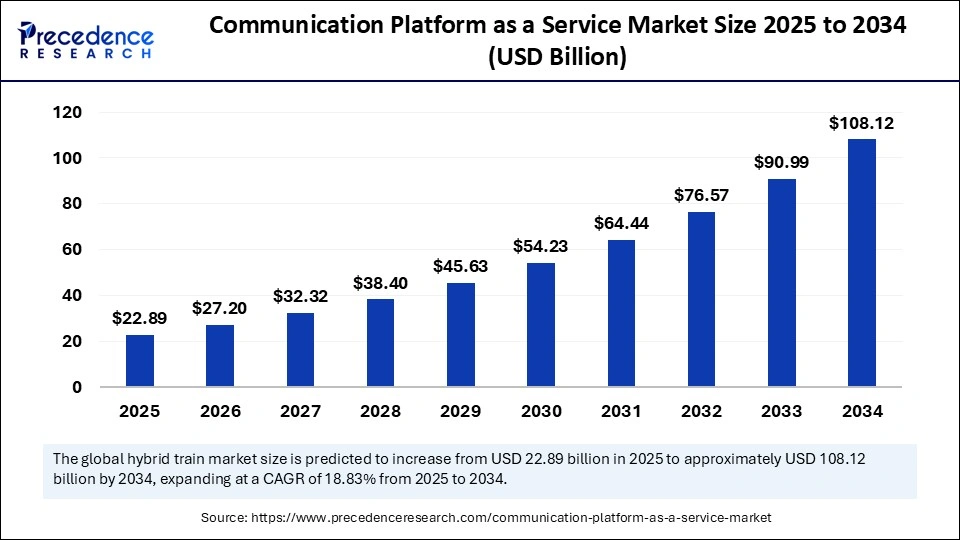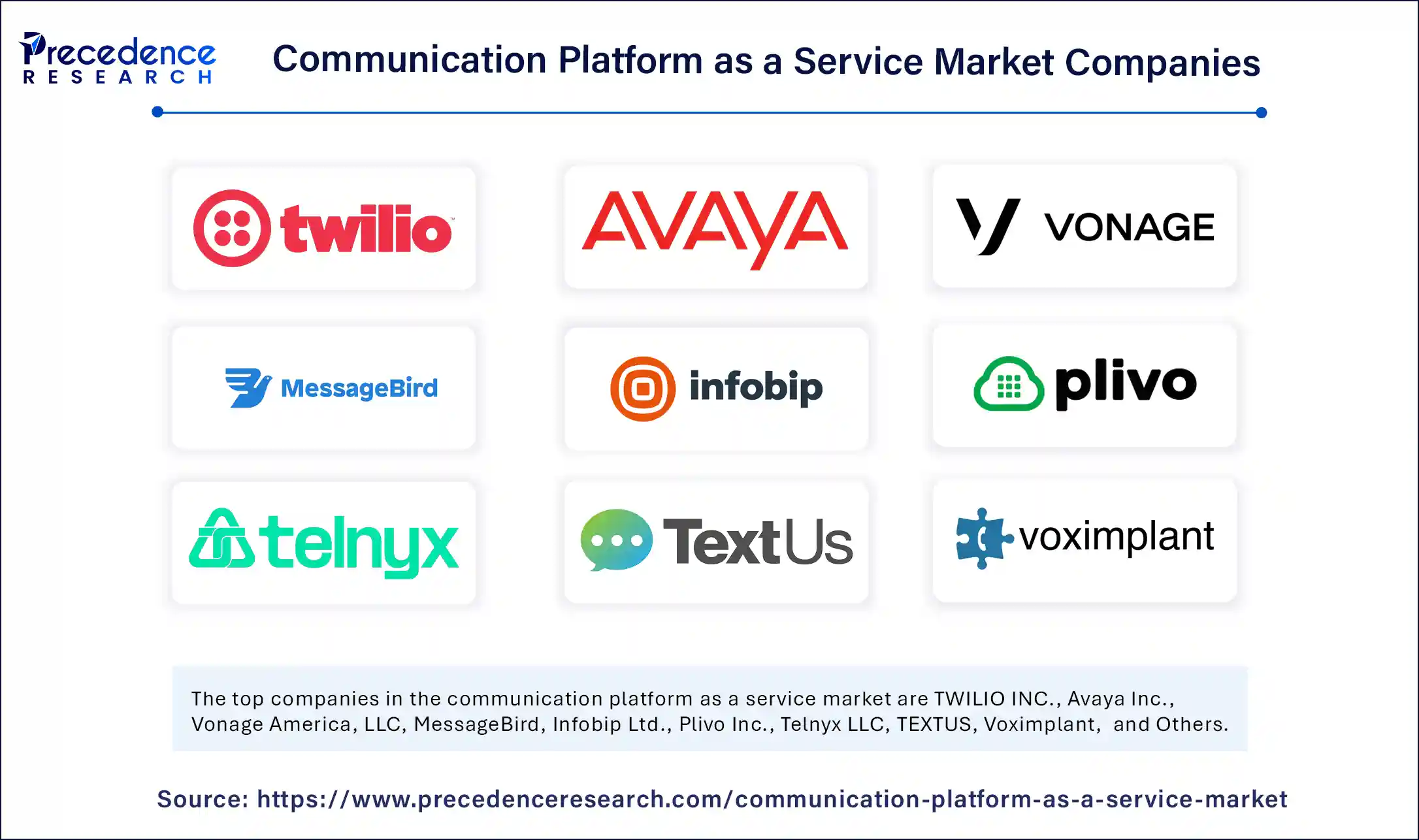
Communication platform as a service market Key Highlights
-
North America led the market with the largest share of 32% in 2024.
-
Asia Pacific is projected to register the fastest CAGR of 31.62% during the forecast period.
-
Europe is expected to expand at a notable CAGR of 25.7% in the upcoming years.
-
By component, the solution segment accounted for the largest share of 86% in 2024.
-
The services segment is anticipated to witness significant growth in its market share over the forecast period.
-
By enterprise size, the large enterprises segment was the leading contributor to the market in 2024.
-
The small and medium enterprises segment is expected to grow at the fastest rate during the projected timeframe.
-
By end user, the BFSI segment dominated the communication platform as a service market in 2024.
-
The healthcare segment is forecasted to grow at the fastest rate in the coming years.
Market Overview
The Communication Platform as a Service (CPaaS) market has rapidly emerged as a transformative force within the broader cloud communications ecosystem. CPaaS is a cloud-based delivery model that enables developers and businesses to embed real-time communication features—such as voice, video, SMS, MMS, and chat—directly into their applications using APIs. This model allows businesses to scale communication without the need to build backend infrastructure, offering a flexible, cost-effective alternative to traditional telecom services.
CPaaS has gained significant traction across industries including retail, BFSI, healthcare, logistics, and customer service, where seamless, omni-channel engagement is a critical success factor. As businesses shift towards digital-first engagement strategies, CPaaS offers the agility and scalability needed to deliver personalized and context-aware communications across diverse platforms. The COVID-19 pandemic further accelerated the adoption of CPaaS as remote work, telehealth, virtual events, and online learning surged, creating an enduring demand for cloud-native communication infrastructure.
Today, CPaaS is not only a technology enabler but a strategic tool for customer experience transformation. As digital engagement becomes the norm, the CPaaS market is poised for robust and sustained growth globally.
Communication Platform as a Service Market Growth Factors
Several structural and technological factors are driving the exponential growth of the CPaaS market. First and foremost is the global digitization of customer interaction. Businesses of all sizes are shifting away from siloed communication systems toward integrated, API-driven solutions that allow faster time to market and real-time engagement.
The rise of mobile-first and remote-first business models is another significant growth enabler. As consumers increasingly prefer messaging apps, push notifications, and in-app support, CPaaS platforms provide the backbone for delivering these services reliably and securely.
Additionally, the expansion of the e-commerce and fintech sectors has created massive demand for scalable, multi-channel communication solutions. From transaction alerts and two-factor authentication to chatbot-driven support and delivery updates, CPaaS enables a consistent, personalized user experience across the customer journey.
Furthermore, the proliferation of APIs and low-code/no-code platforms has made it easier than ever for non-developers to integrate communication features into apps, accelerating adoption across industries. Businesses can now create tailored communication workflows without heavy IT investments or telecom partnerships.
Impact of AI on the Communication Platform as a Service Market
Artificial Intelligence (AI) is deeply interwoven into the evolution and value proposition of CPaaS platforms. On the operational side, AI enhances the intelligence and automation of customer communication workflows. AI-driven bots, virtual agents, and natural language processing (NLP) capabilities are now commonly integrated into CPaaS offerings, enabling conversational interfaces that can handle complex queries and provide personalized experiences at scale.
AI is also being used to improve call routing and sentiment analysis, ensuring that customer inquiries are directed to the right agents or resources, and providing businesses with actionable insights into customer behavior and satisfaction. With machine learning algorithms, CPaaS platforms can automatically optimize communication timing, channel selection, and message content for better engagement outcomes.
Moreover, AI enhances fraud prevention and security, particularly in sectors like banking and healthcare. Real-time AI-powered identity verification, voice biometrics, and behavioral analytics embedded within CPaaS APIs help ensure secure and compliant communications.
Finally, AI supports predictive analytics and performance monitoring, allowing enterprises to fine-tune their communication strategies, identify bottlenecks, and increase ROI on their engagement efforts. AI doesn’t just enhance CPaaS capabilities—it is becoming a core differentiator in a competitive market.
Market Scope
| Report Coverage | Details |
| Market Size by 2034 | USD 108.12 Billion |
| Market Size in 2025 | USD 22.89 Billion |
| Market Size in 2024 | USD 19.26 Billion |
| Market Growth Rate from 2025 to 2034 | CAGR of 18.83% |
| Dominating Region | North America |
| Fastest Growing Region | Asia Pacific |
| Base Year | 2024 |
| Forecast Period | 2025 to 2034 |
| Segments Covered | Component, Enterprise Size, End User, and Region |
| Regions Covered | North America, Europe, Asia-Pacific, Latin America, and Middle East & Africa |
Market Drivers
The CPaaS market is being strongly driven by the shift toward omni-channel customer engagement. Businesses today are expected to meet customers on their preferred platforms—whether it’s SMS, WhatsApp, video chat, or push notifications. CPaaS platforms enable seamless integration across these channels, creating a unified and consistent user experience.
Another critical driver is the growing demand for personalization and real-time communication. Consumers expect instant responses and contextual interactions. CPaaS solutions allow businesses to meet these expectations by integrating communication flows directly into apps, CRMs, and enterprise systems.
Scalability and flexibility are also powerful motivators. Unlike legacy telecom systems, CPaaS platforms allow organizations to scale communication capabilities up or down based on business needs, reducing capital expenditures and enabling agile deployment.
Moreover, cost-efficiency and speed to market are compelling benefits. CPaaS removes the need for building and maintaining expensive communication infrastructure, allowing companies to launch new services quickly, test use cases, and innovate without large upfront investments.
Opportunities
The CPaaS market is ripe with opportunities across verticals and regions. One major opportunity lies in industry-specific CPaaS solutions, particularly for sectors like healthcare, education, and logistics. Tailored APIs for appointment reminders, virtual consultations, patient monitoring, and secure messaging can help providers meet growing regulatory and user experience demands.
There is also a significant opportunity in emerging markets, where mobile penetration is high but traditional telecom infrastructure remains limited. CPaaS provides an agile and low-barrier path for businesses in Latin America, Africa, and Southeast Asia to deliver advanced communication services without heavy infrastructure investment.
Integration with IoT and wearable technologies represents another frontier. CPaaS platforms can support device-to-human communication, enabling real-time alerts, remote diagnostics, and usage updates in smart home, health monitoring, and industrial IoT applications.
Additionally, partnerships between CPaaS providers and telecom operators are creating opportunities to combine global reach with cloud-based innovation. These partnerships can accelerate deployment in heavily regulated regions and improve service quality.
Challenges
Despite its rapid growth, the CPaaS market faces several challenges. One of the most prominent is data privacy and compliance. With communication spanning borders and industries like healthcare and finance, CPaaS providers must navigate a complex web of regulations including GDPR, HIPAA, CCPA, and industry-specific standards.
Security concerns, particularly around identity theft, phishing, and message spoofing, remain major obstacles. Ensuring end-to-end encryption, secure API gateways, and real-time threat detection are critical but resource-intensive tasks for providers.
Another challenge is market fragmentation and vendor competition. With numerous providers offering overlapping features, differentiation becomes increasingly difficult. Enterprises must assess platforms based on reliability, scalability, and ecosystem integration, which can be complex and time-consuming.
Additionally, latency and quality of service remain concerns, especially for video and voice applications in remote or underserved regions. CPaaS providers must continually invest in network optimization and global server coverage to ensure consistent performance.
Regional Outlook
North America leads the global CPaaS market, driven by the presence of major tech players, early digital transformation initiatives, and a strong culture of SaaS adoption. The U.S. in particular is home to leading CPaaS providers and is witnessing strong adoption in banking, retail, and telehealth.
Europe is a rapidly growing market, supported by regulatory compliance needs and a maturing digital economy. The region places high emphasis on data privacy and secure communication, making CPaaS a strategic investment for enterprises navigating GDPR and localized compliance challenges.
Asia-Pacific is the fastest-growing region, fueled by the digital revolution in countries like India, China, Japan, and South Korea. The region’s large mobile user base, increasing e-commerce penetration, and government-backed digitization programs make it fertile ground for CPaaS expansion.
Latin America is seeing rising adoption of CPaaS as businesses seek cost-effective ways to communicate with a mobile-first customer base. Industries like fintech, e-learning, and healthcare are particularly active.
The Middle East and Africa present long-term growth potential, especially as digital infrastructure improves. Governments and enterprises in the region are increasingly investing in cloud-based platforms to support smart cities, mobile banking, and public service delivery.
Communication platform as a service market Companies

- TWILIO INC.
- Avaya Inc.
- Vonage America, LLC
- MessageBird
- Infobip Ltd.
- Plivo Inc.
- Telnyx LLC
- TEXTUS
- Voximplant
- Bandwidth Inc.
Segments Covered in the Report
By Component
- Solution
- API Platform
- Messaging API
- Voice API
- Video API
- Others
- SDK Platform
- Service
- Managed Services
- Professional Services
By Enterprise Size
- Large Enterprises
- Small & Medium Enterprises (SMEs)
By End User
- BFSI
- IT & Telecom
- Retail & E-commerce
- Healthcare
- Transportation & Logistic
- Travel & Hospitality
- Others
By Region
- North America
- Europe
- Asia-Pacific,
- Latin America
- Middle East & Africa
Also Read: Isononanoic Acid Market
Get this report to explore global market size, share, CAGR, and trends, featuring detailed segmental analysis and an insightful competitive landscape overview @ https://www.precedenceresearch.com/sample/6102
You can place an order or ask any questions, please feel free to contact at sales@precedenceresearch.com|+1 804 441 9344